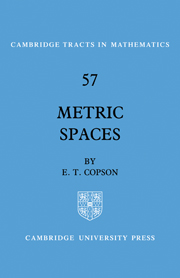4 - Complete Metric Spaces
Published online by Cambridge University Press: 06 January 2010
Summary
Convergent sequences
The sequence of points {an} in a metric space M is said to converge to a point a of M if the distance ρ(an, a) tends to zero as n → ∞, that is, if for every positive value of ∈ there exists an integer n0, depending on ∈, such that
whenever n ≥ n0. The point a is called the limit of the sequence. We say the limit, because no sequence can converge to two limits; for if {an} converged to a and to b, we should have
as n → ∞, and so ρ(a, b) = 0 which is impossible since a and b are distinct.
In particular, if an = a for all but a finite number of values of n, the sequence {an} converges to a.
If {kn} is a strictly increasing sequence of positive integers, so
that kn ≥ n and kn → ∞ as n → ∞, the sequence {akn} is called a subsequence of {an}; and if an → a.
We recall that a sequence is not a set. The elements in a sequence are ordered and are not necessarily distinct; the elements in a set are not ordered and are distinct. For example, we could define a sequence by a2n = b, a2n+1 = c where b ≠ c; the values taken by an form a set with only two members.
- Type
- Chapter
- Information
- Metric Spaces , pp. 46 - 61Publisher: Cambridge University PressPrint publication year: 1968

